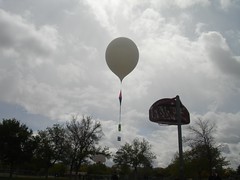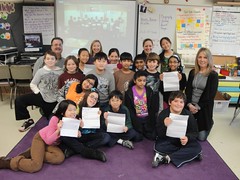Mr. Brian Crosby - Back to the Future

As I watched Mr. Brian Crosby's TEDxDenver ED presentation, Back to the Future, I was amazed how one science experiment could "encompass a huge range of learning". At one point, Mr. Crosby, introduces a slide, and if it was the only thing you saw, you might believe this to be an English/Language class.
The slide says...
Language Intense:
Read/Write to learn - content
Writing to clarify and share
Write to tell a story, creativity
Feedback
Articulate Orally
Connect globally / Aware globally
Authentic Audience
Remember the science, High Hopes, art?
He talks about how all of these language skills are very important for a class which includes mostly 2nd language learners. In addition to these skills and the science material, I also noticed that they experimented, reviewed history(hot air balloons), used photography, and read maps.
 I was very impressed that Mr. Crosby is able to incorporate all of these learning experiences into one subject, but what was equally impressive, was how he engaged his students in learning. I couldn't help but pick up on how many different tools he uses with his class at Agnes Risley Elementary School. I heard Mr. Crosby mention laptops, interactive white board, digital cameras, individual blogs, collaboration with UNR professors, videos, Wiki, free online software for designing book covers and trading(strato)cards, a learning network, Skype, Flickr, Web 2.0, radiosonde, Google maps, and yes, he did mention they used the science book a little bit. Why do you need all of this for a weather balloon experiment?
I was very impressed that Mr. Crosby is able to incorporate all of these learning experiences into one subject, but what was equally impressive, was how he engaged his students in learning. I couldn't help but pick up on how many different tools he uses with his class at Agnes Risley Elementary School. I heard Mr. Crosby mention laptops, interactive white board, digital cameras, individual blogs, collaboration with UNR professors, videos, Wiki, free online software for designing book covers and trading(strato)cards, a learning network, Skype, Flickr, Web 2.0, radiosonde, Google maps, and yes, he did mention they used the science book a little bit. Why do you need all of this for a weather balloon experiment?Mr. Crosby uses all of these tools to engage his students in "active learning - empowering students to become learners". He believes learning should take place in a context that is both motivational and meaningful. As Mr. Crosby states, he wants to give every student the opportunity to "shine".
Mr. Andersen - The Blended Learning Cycle
Is this a picture of the Blended Learning Cycle?
Mr. Paul Andersen is a high school AP Biology teacher in Bozeman, Montana and he has made a YouTube video title Blended Learning Cycle. In this video he describes blended learning as taking the compelling parts of online, mobile, and classroom learning and blending them together to incorporate technology into the classroom. Then he talks about the Learning Cycle in which students first engage, then they explore, expand, explain, and evaluate. By putting these two types of learning together, you create a Blended Learning Cycle. Mr. Andersen created an acronym for this cycle and it is Quivers, which stands for...
Investigate
Video
Elaboration
Review
Summary quiz
Mr. Andersen explains that you first need a good question because that's the hook in learning. Students can't move to the other stages until they are first engaged in learning. Once he has their interest in a subject, he then encourages students to investigate through assigned reading materials. He enhances his instruction with videos. After the first three stages, Mr. Andersen expects his students to be able to elaborate on the assigned topic. The next part is my favorite; the review. I was very impressed that Mr. Andersen takes the time to review with each student what they have learned before he allows them to take a quiz. This tells me that Mr. Andersen has a personal interest in what his students are learning and he is not relying solely on testing to determine a student's success. I think this is the ideal strategy because the focus is placed on the student and their level of learning. He talks more about his teaching style in Reflections on the Flipped Classroom. Mr. Andersen has set a goal of moving from a passive, teacher centered classroom to an active, student centered classroom. I believe we heard a similar message in the above TEDx video by Mr. Crosby. As teachers, we need to engage students in "active learning". Teachers like Mr. Crosby and Mr. Andersen are an inspiration because they illustrate how to take learning to a new level, to make it exciting, and to make the focus of education the student, not just the subject.


Hey Tonya!
ReplyDeleteYour blog post was interesting to read and I completely agree with you that Mr. Crosby is very impressive the way he incorporates all of the different types of technology into one project! I also agree that QUIVERS allows active learning and is very beneficial to any teacher! Great post